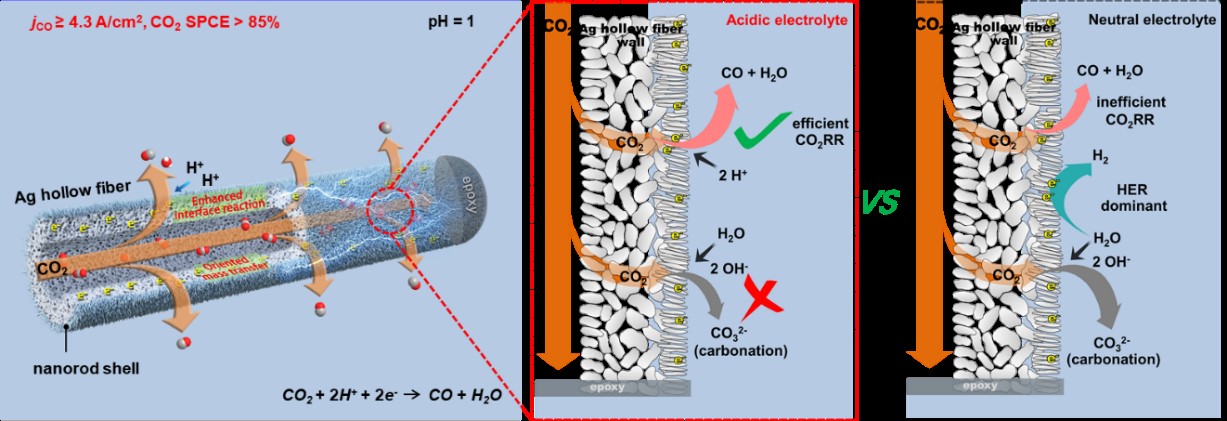Research Progress
The electrochemical conversion of CO2 driven by renewable electricity can produce value-added chemicals and feedstocks while mitigating CO2 emissions. Synthesis of valuable chemicals from CO2 electroreduction in acidic media can overcome carbonation, however, how to suppress the hydrogen evolution reaction in such proton-rich environments is very challenging.
In a study published in Nature Communications, Prof. WEI Wei and Prof. CHEN Wei from Shanghai Advanced Research Institute of the Chinese Academy of Sciences constructed a hierarchical Ag hollow-fiber penetration electrode(HPE), which helped to realize high-efficiency CO2 electroreduction in strongly acidic electrolytes at ampere-level current density.
Previous studies by the research team have indicated that the HPE with a compact structure has shown promising potential for high-rate and efficient CO2 reduction due to enhanced mass transport, thus realizing the generation of CO, formate and C2+ products under ampere-level current density.
In order to further explore the efficient working mechanism of HPE in acid system, an Ag2CO3-derived hierarchical micro/nanostructured silver HPE (CD-Ag HPE) was developed to investigate the effects of catalyst microenvironments on CO2 electrolysis performance in an acidic medium (pH =1).
Experiments and theoretical studies demonstrated that the the presence of K+ in the acidic electrolyte controlled the onset of the electrocatalytic CO2 reduction reaction (CO2RR), and that a moderate concentration of H+ effectively prevented the carbonation of CO2 and CO2RR active sites due to the precipitation of (bi)carbonate, ensuring sufficient CO2 and CO2RR active sites at the catalyst surface for high-efficiency CO2RR at ampere-level current density.
By optimizing the K+ and H+ concentration and CO2 flow rate in a strong acidic electrolyte, a high CO faradaic efficiency of 95% at 4.5 A/cm2 and a 200 h of stability testing at 2 A/cm2 were achieved.
In addition, by limiting the availability of input CO2, the CO2 single-pass carbon efficiency for CO2RR reached 87% at a high j of 2 A/cm2, demonstrating remarkable CO2 conversion capability.
This study paves the way for high-efficiency CO2 conversion in strong acid by modulating catalyst microenvironments, which has great potential for practical application.

Figure. Schematic of Ag hollow fiber penetration electrode for boosting CO2 electroreduction to CO in a strongly acidic electrolyte (Image by SARI)





